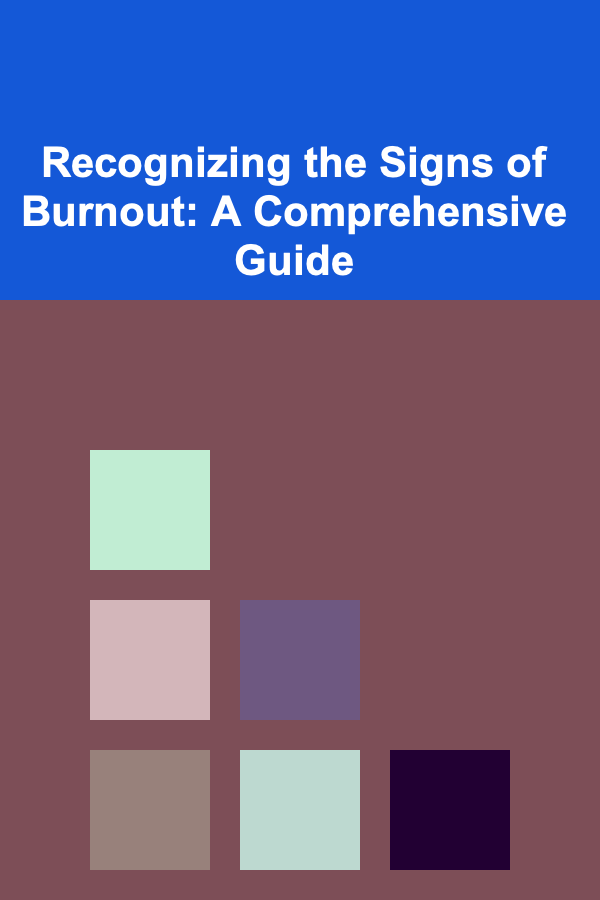
Recognizing the Signs of Burnout: A Comprehensive Guide
ebook include PDF & Audio bundle (Micro Guide)
$12.99$11.99
Limited Time Offer! Order within the next:

Burnout is a state of emotional, physical, and mental exhaustion caused by prolonged or excessive stress. It's not just feeling tired; it's a deep-seated depletion of energy and motivation that can significantly impact various aspects of life, from work performance to personal relationships and overall well-being. Recognizing the signs of burnout is crucial for early intervention and preventing more serious health consequences. This comprehensive guide delves into the various indicators of burnout, helping you identify them in yourself and others, and understand the underlying mechanisms driving this pervasive condition.
Understanding the Core Dimensions of Burnout
The concept of burnout isn't simply about being overworked. It's characterized by three distinct dimensions, as first described by Christina Maslach, a pioneering researcher in the field:
- Exhaustion: This is the feeling of being emotionally, physically, and mentally drained. It's more than just regular fatigue; it's a persistent sense of depletion that sleep and rest don't seem to alleviate. It manifests as a lack of energy, chronic tiredness, and a feeling of being overwhelmed.
- Cynicism (or Depersonalization): This involves a negative, detached, and cynical attitude towards work or the people associated with it. Individuals experiencing cynicism might become increasingly irritable, resentful, and distant from colleagues or clients. They may also develop a general sense of disillusionment with their work and its purpose. This distancing is often a defense mechanism against the overwhelming demands and emotional toll of the situation.
- Reduced Personal Accomplishment (or Inefficacy): This is the feeling of incompetence, lack of productivity, and a sense of failure, even when objectively performing well. Individuals experiencing reduced personal accomplishment may feel that their efforts are not making a difference, leading to a decline in motivation and a lack of confidence in their abilities. They may also feel discouraged and defeated, questioning their value and purpose in their role.
Early Warning Signs of Burnout: Subtle Clues Not to Ignore
Burnout often develops gradually, with subtle signs appearing before the more pronounced symptoms. Recognizing these early indicators is key to preventing the condition from escalating. These early warning signs can be categorized into several areas:
Physical Symptoms
- Persistent Fatigue: Beyond just feeling tired after a long day, this is a relentless exhaustion that persists despite adequate sleep. It might feel like a heavy weight constantly dragging you down.
- Changes in Sleep Patterns: This can manifest as insomnia (difficulty falling or staying asleep), hypersomnia (excessive sleepiness), or disrupted sleep with frequent awakenings. Stress hormones can interfere with sleep cycles, leading to these disruptions.
- Frequent Headaches or Muscle Tension: Stress can manifest physically as headaches, particularly tension headaches, or muscle tension in the neck, shoulders, and back. These are often a result of prolonged stress and anxiety.
- Digestive Problems: Stress can significantly impact the digestive system, leading to symptoms like stomachaches, indigestion, changes in appetite, constipation, or diarrhea. The gut-brain axis is highly sensitive to stress hormones.
- Weakened Immune System: Chronic stress suppresses the immune system, making individuals more susceptible to colds, flu, and other infections. This is because stress hormones interfere with the production and function of immune cells.
Emotional Symptoms
- Increased Irritability: A short temper and increased frustration with minor inconveniences are common signs. This irritability often stems from feeling overwhelmed and lacking the resources to cope effectively.
- Anxiety and Worry: Constant worrying, feeling on edge, and experiencing panic attacks can be indicators of burnout. These feelings are often related to performance pressures, workload demands, and a lack of control.
- Sadness or Depression: A persistent feeling of sadness, hopelessness, or a loss of interest in activities that were once enjoyable can signal burnout. This can also be a sign of developing depression, which can be exacerbated by chronic stress.
- Feeling Overwhelmed: A sense of being constantly bombarded with tasks and responsibilities, making it difficult to prioritize and manage time effectively. This can lead to a feeling of being constantly behind and unable to catch up.
- Emotional Numbness: A feeling of detachment and emotional flatness, making it difficult to experience joy, sadness, or other emotions. This can be a coping mechanism to protect oneself from the overwhelming emotional demands.
Behavioral Symptoms
- Procrastination and Avoidance: Delaying tasks, putting things off until the last minute, or avoiding work-related activities altogether. This is often a result of feeling overwhelmed and lacking the motivation to start.
- Increased Cynicism: Negative or critical comments, complaining frequently, and a general sense of disillusionment with work. This reflects a loss of faith in the organization, the work itself, and the people involved.
- Social Withdrawal: Decreasing social interaction, avoiding colleagues, and isolating oneself from friends and family. This is often a result of feeling emotionally drained and lacking the energy to maintain social connections.
- Changes in Eating Habits: Eating more or less than usual, skipping meals, or relying on unhealthy comfort foods. Stress can disrupt normal eating patterns and lead to unhealthy coping mechanisms.
- Increased Use of Alcohol, Drugs, or Other Substances: Turning to substances to cope with stress, anxiety, or emotional pain. This can lead to addiction and further health problems.
- Difficulty Concentrating: Trouble focusing, making mistakes, and experiencing memory lapses. Chronic stress impairs cognitive function and makes it difficult to concentrate.
Work-Related Symptoms
- Decreased Productivity: A noticeable decline in work performance, making more errors, and struggling to meet deadlines. This is a direct result of exhaustion and reduced motivation.
- Feeling Unappreciated: A sense that one's efforts are not recognized or valued by supervisors or colleagues. This can lead to resentment and a feeling of being undervalued.
- Loss of Motivation: A lack of enthusiasm for work, feeling uninspired, and struggling to find meaning in one's role. This is a key indicator of burnout and a sign that the individual is losing touch with their values and purpose.
- Increased Absenteeism or Tardiness: Taking more sick days or arriving late to work more frequently. This can be a sign of physical or emotional exhaustion and a desire to avoid the stressors associated with work.
- Working Longer Hours Without Increased Output: Spending more time at work but accomplishing less, indicating inefficiency and a struggle to maintain focus. This is often a counterproductive attempt to compensate for decreased productivity.
Delving Deeper: Psychological and Cognitive Impacts of Burnout
Beyond the physical, emotional, and behavioral manifestations, burnout profoundly affects cognitive functions and overall psychological well-being. Recognizing these impacts is crucial for understanding the severity of the condition and implementing targeted interventions.
Cognitive Impairment
Chronic stress and burnout can significantly impair cognitive functions, affecting memory, attention, and decision-making. Studies have shown that individuals experiencing burnout exhibit reduced prefrontal cortex activity, a brain region crucial for executive functions. This impairment manifests as:
- Memory Problems: Difficulty remembering names, dates, or recent events. This is often due to the impact of stress hormones on the hippocampus, a brain region essential for memory formation.
- Difficulty Concentrating: Struggling to focus on tasks, easily distracted, and experiencing mental fatigue. This makes it difficult to perform complex tasks and maintain attention for extended periods.
- Impaired Decision-Making: Making poor judgments, having difficulty weighing options, and experiencing indecisiveness. This is due to the impact of stress on the prefrontal cortex, which is responsible for rational decision-making.
- Reduced Creativity: A decline in creative thinking, difficulty generating new ideas, and a sense of mental block. This is because burnout can stifle the creative process by reducing energy and motivation.
Psychological Distress
Burnout is closely linked to various forms of psychological distress, including anxiety, depression, and a diminished sense of self-worth. The chronic stress associated with burnout can trigger or exacerbate existing mental health conditions. Key indicators of psychological distress include:
- Increased Anxiety: Feeling constantly worried, anxious, or on edge. This can manifest as generalized anxiety disorder (GAD), panic attacks, or social anxiety.
- Depression: Experiencing persistent sadness, hopelessness, and a loss of interest in activities. This can lead to major depressive disorder, which requires professional treatment.
- Low Self-Esteem: Having a negative self-image, feeling inadequate, and lacking confidence in one's abilities. This can contribute to feelings of worthlessness and despair.
- Sense of Helplessness: Feeling unable to control one's situation or to make positive changes. This can lead to a sense of learned helplessness and resignation.
- Cynicism and Isolation: Developing a negative and detached attitude towards others, withdrawing from social interactions, and feeling isolated and alone. This can further exacerbate feelings of depression and anxiety.
The Impact on Relationships
Burnout can strain relationships with family, friends, and colleagues. The emotional exhaustion and irritability associated with burnout can make it difficult to maintain healthy relationships. Common relational impacts include:
- Increased Conflict: Having more frequent arguments with loved ones and colleagues due to increased irritability and frustration. Communication breakdowns can also contribute to conflict.
- Withdrawal from Social Activities: Avoiding social gatherings and spending less time with friends and family. This can lead to feelings of isolation and loneliness.
- Difficulty Empathizing: Struggling to understand and respond to the emotions of others. Emotional exhaustion can impair one's ability to empathize and connect with others.
- Negative Communication Patterns: Using sarcastic, critical, or dismissive language in interactions with others. This can damage relationships and create further conflict.
- Feeling Emotionally Unavailable: Being unable to provide emotional support to loved ones due to emotional exhaustion. This can strain relationships and create feelings of resentment.
Differentiating Burnout from Depression and Stress
While burnout shares some symptoms with depression and general stress, it's important to distinguish between these conditions for accurate diagnosis and effective treatment. Burnout is primarily work-related, while depression is a more pervasive mood disorder. General stress, while unpleasant, doesn't necessarily involve the cynicism and reduced personal accomplishment characteristic of burnout.
Burnout vs. Depression
- Focus: Burnout is typically focused on work-related stressors and feelings, whereas depression affects all aspects of life.
- Cynicism: Cynicism and detachment are core components of burnout, while they may be present in depression, they aren't defining features.
- Personal Accomplishment: Reduced personal accomplishment is a key feature of burnout, whereas depression often involves a more generalized sense of worthlessness.
Burnout vs. Stress
- Duration: Stress is often a short-term response to a specific event or situation, while burnout is a chronic condition resulting from prolonged stress.
- Exhaustion: Exhaustion in burnout is more profound and persistent than typical stress-related fatigue.
- Coping Mechanisms: Individuals experiencing stress may still be able to cope effectively, while those experiencing burnout often struggle to find effective coping strategies.
It's important to consult with a healthcare professional for an accurate diagnosis and appropriate treatment plan. Self-diagnosing can be misleading, and professional help is crucial for addressing these complex conditions.
Risk Factors for Burnout: Understanding the Vulnerabilities
Certain individuals and work environments are more susceptible to burnout. Understanding these risk factors can help identify vulnerable individuals and create more supportive and sustainable work environments.
Individual Risk Factors
- Perfectionism: Setting unrealistically high standards and striving for flawless performance.
- High Achiever: Driven by achievement and constantly seeking validation through work.
- People-Pleaser: Difficulty saying "no" and prioritizing the needs of others over their own.
- Lack of Boundaries: Difficulty separating work from personal life and constantly being "on call."
- Low Self-Esteem: Needing external validation and approval, making them more vulnerable to criticism and pressure.
- Poor Coping Skills: Lacking effective strategies for managing stress and emotional distress.
Workplace Risk Factors
- Heavy Workload: Excessive demands and insufficient resources to meet them.
- Lack of Control: Limited autonomy over one's work and decision-making processes.
- Insufficient Recognition: Feeling unappreciated and undervalued for one's contributions.
- Unfair Treatment: Experiencing discrimination, bias, or unequal opportunities.
- Role Ambiguity: Unclear expectations and responsibilities, leading to confusion and stress.
- Poor Communication: Lack of open and honest communication between employees and management.
- Lack of Social Support: Insufficient support from colleagues and supervisors.
- Toxic Work Environment: Experiencing bullying, harassment, or other forms of mistreatment.
- Values Mismatch: Feeling that one's personal values are not aligned with the organization's values.
Taking Action: Steps Towards Prevention and Recovery
Recognizing the signs of burnout is just the first step. Taking proactive steps to prevent burnout and recover from it is essential for maintaining well-being and a healthy work-life balance.
Prevention Strategies
- Set Realistic Goals: Break down large tasks into smaller, more manageable steps.
- Prioritize Self-Care: Make time for activities that promote relaxation, stress reduction, and emotional well-being.
- Establish Boundaries: Set clear boundaries between work and personal life.
- Learn to Say "No": Avoid overcommitting and prioritize tasks based on importance and feasibility.
- Seek Social Support: Connect with friends, family, and colleagues for emotional support and encouragement.
- Practice Mindfulness: Engage in mindfulness exercises to reduce stress and improve focus.
- Develop Healthy Coping Mechanisms: Identify and practice healthy ways to manage stress, such as exercise, yoga, or meditation.
- Advocate for Workplace Changes: Communicate concerns to supervisors and advocate for a more supportive and sustainable work environment.
Recovery Strategies
- Seek Professional Help: Consult with a therapist or counselor to address underlying issues and develop coping strategies.
- Take Time Off: Consider taking a vacation or extended break to recharge and recover.
- Reduce Workload: Negotiate with supervisors to reduce workload and prioritize tasks.
- Delegate Tasks: Delegate responsibilities to others when possible.
- Re-evaluate Priorities: Identify what is truly important and focus on activities that align with personal values.
- Find Meaning and Purpose: Reconnect with the reasons why you chose your career and identify ways to find meaning in your work.
- Practice Self-Compassion: Treat yourself with kindness and understanding, especially during difficult times.
- Engage in Hobbies: Rediscover hobbies and activities that bring joy and fulfillment.
Burnout is a serious condition that can have significant consequences for individuals and organizations. By recognizing the signs of burnout, understanding the risk factors, and implementing preventive and recovery strategies, we can create healthier and more sustainable work environments that promote well-being and prevent this debilitating condition.

Beyond Basics: Advanced Audio Engineering for Professionals
Read More
How to Maintain Your Home's Lawn and Garden for Healthy Growth
Read More
How to Sell Artwork on Etsy: An Actionable Guide
Read More
How to Stage a Rental Property for Short-Term Tenants
Read More
How to Use Print-on-Demand Services to Make Money
Read More
The Biomedical Engineer's Guide: Innovating Healthcare Through Technology
Read MoreOther Products

Beyond Basics: Advanced Audio Engineering for Professionals
Read More
How to Maintain Your Home's Lawn and Garden for Healthy Growth
Read More
How to Sell Artwork on Etsy: An Actionable Guide
Read More
How to Stage a Rental Property for Short-Term Tenants
Read More
How to Use Print-on-Demand Services to Make Money
Read More